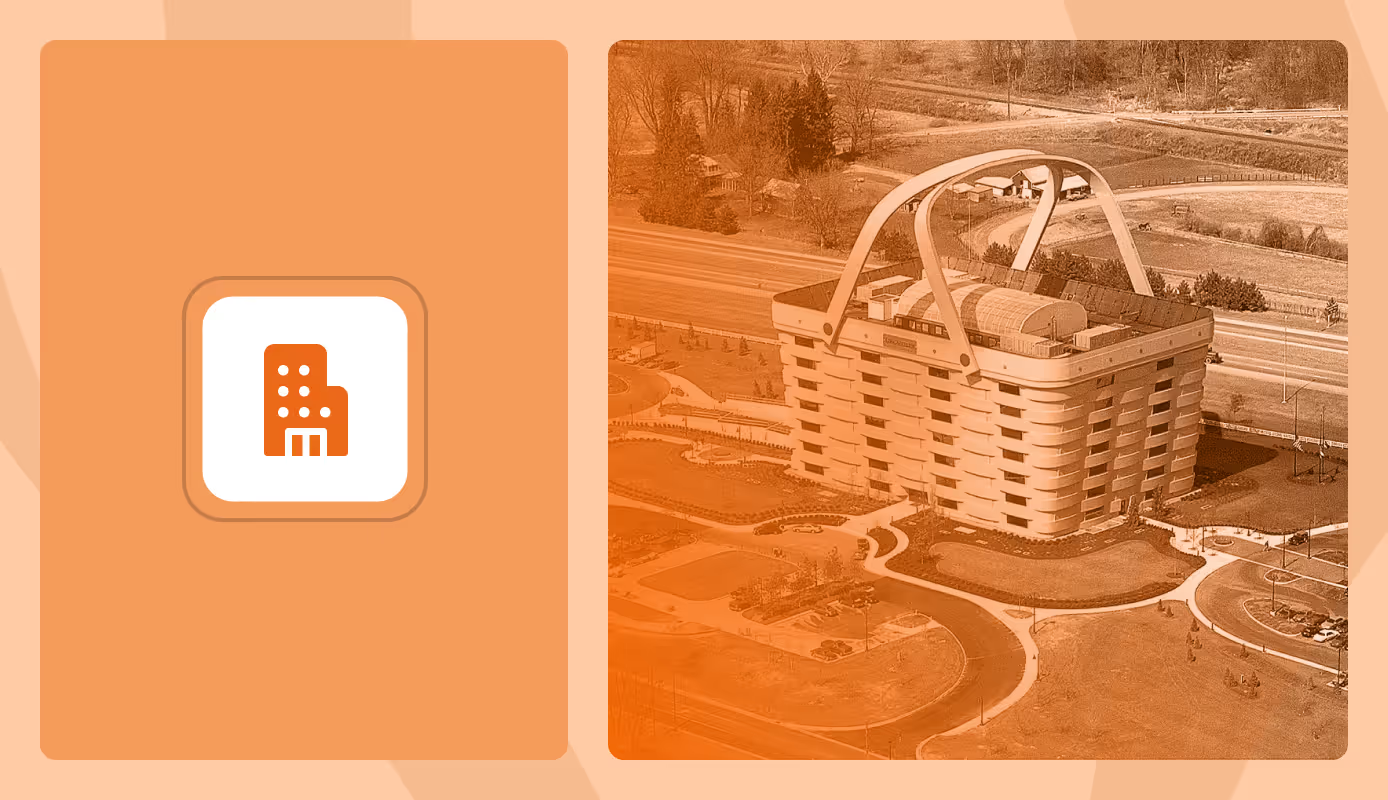Unique buildings push the boundaries of architecture. Whether they curve, twist, float, or resemble a teapot or shoe, these structures challenge architectural norms. But behind every one is a real project with planning approvals, structural challenges, and client demands.
LetŌĆÖs look at the 20 most unique buildings in the world that pushed boundaries in form, function, or both. Whether you're into architecture or just curious about whatŌĆÖs possible in construction, there's something here for you.
1. Basket Building: The Giant Woven Office
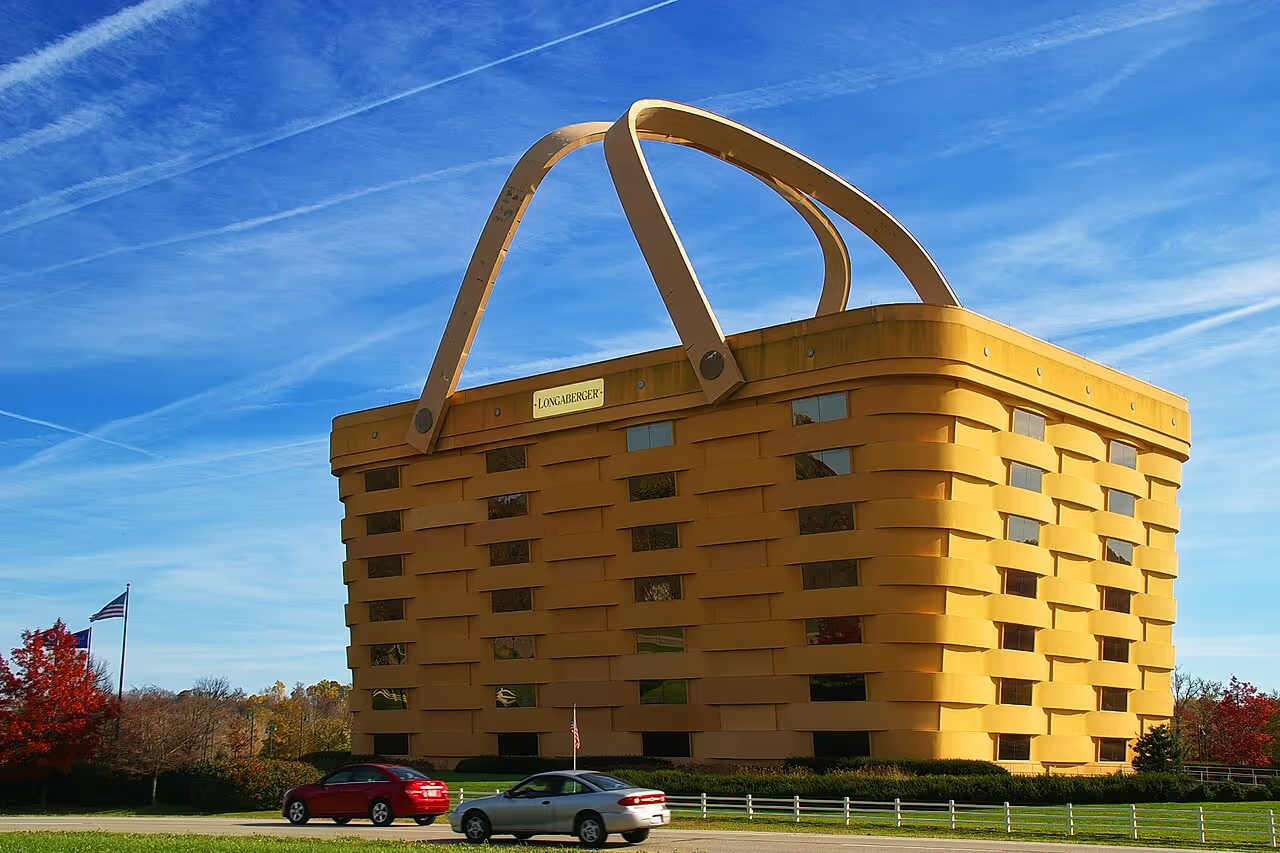
The Basket Building is a seven-story crazy building that looks exactly like an oversized woven basket, handles and all. It was built as the former headquarters for the Longaberger Company, which sold handcrafted wooden baskets.
Although the building basket was once a bustling office space, the building sat vacant for years after the company downsized. In 2020, it was purchased by a developer who .
- Location: Newark, Ohio, USA
- Construction timeline: 1995 - 1997
- Architect / Firm: NBBJ and Korda/Nemeth Engineering
- Style or movement: Novelty architecture
- Materials or unique features: Steel frame, stucco cladding shaped like woven wood
- Engineering method: Custom exterior moldings; structural steel formed for handle elements
- Original use: Corporate headquarters for Longaberger Baskets
- Current use: Under renovation for use as a hotel
- Public access: No (viewable from outside)
- Construction cost: Approx. $30 million
LongabergerŌĆÖs founder, Dave Longaberger, personally insisted that the Basket Building look like the companyŌĆÖs best-selling basket. At the time, he even wanted every branch office to follow the same concept. That never happened, but the original basket HQ became an icon of American roadside architecture.
2. Dancing House: PragueŌĆÖs Curvy Landmark
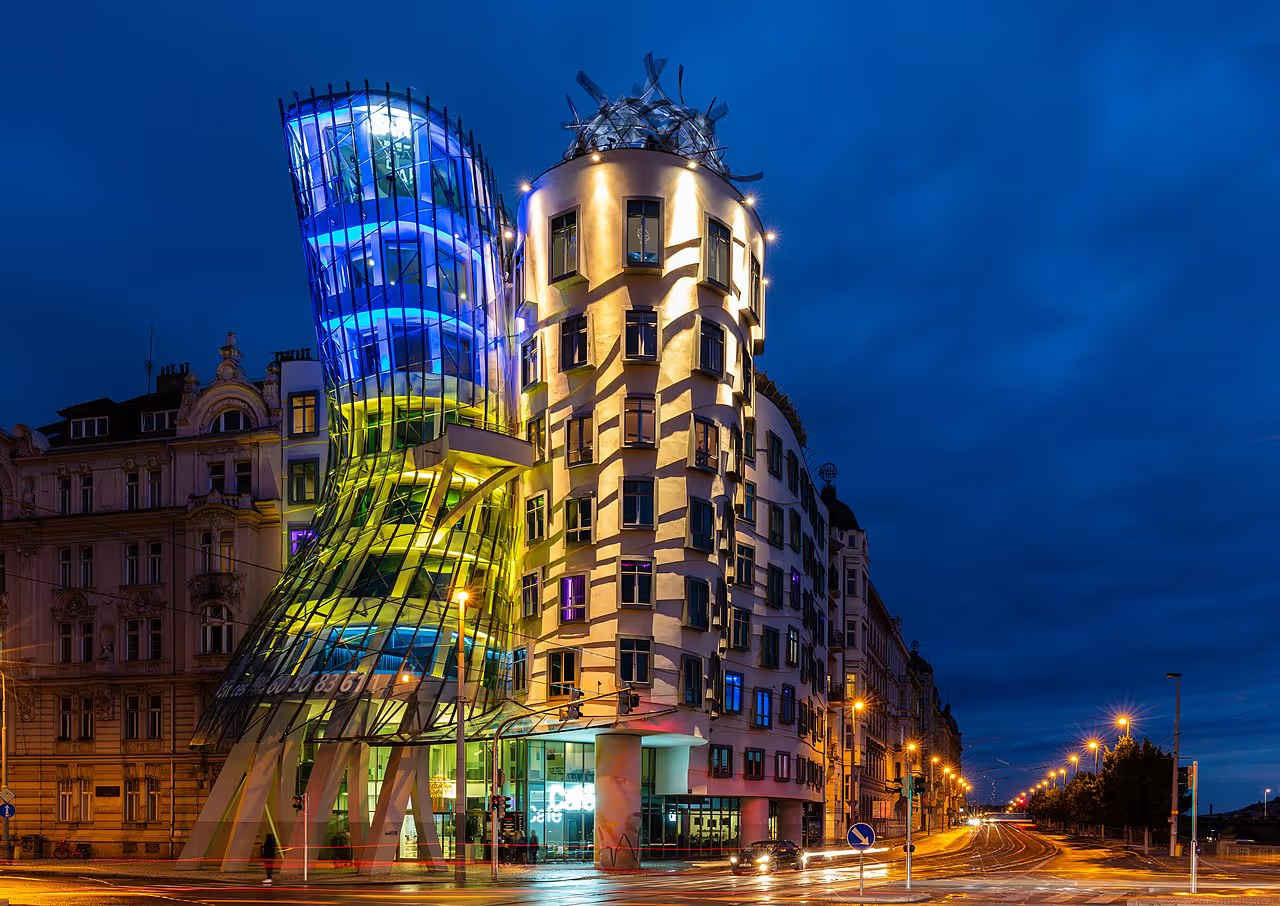
Nicknamed ŌĆ£Fred and Ginger,ŌĆØ the is a curved glass-and-concrete structure that appears to sway like two dancers in motion. The contrast with the surrounding Baroque and Gothic buildings stirred debate when it opened. But it's now seen as one of the most unique buildings in the world.
Designed as an office building, the Dancing House now has a restaurant, gallery, and event space. Visitors can go to the top-floor caf├® for views of the Vltava River and Prague Castle. ItŌĆÖs open to the public and remains one of the cityŌĆÖs most photographed landmarks.
- Location: Prague, Czech Republic
- Construction timeline: 1994 - 1996
- Architect / Firm: Vlado Miluni─ć and Frank Gehry
- Style or movement: Deconstructivist
- Materials or unique features: Glass curtain wall, 99 concrete panels, metal ŌĆ£domeŌĆØ
- Engineering method: Irregularly shaped floor plates; custom concrete molds
- Original use: Office building
- Current use: Offices, caf├®, gallery
- Public access: Yes (limited areas)
- Construction cost: Approx. $11 million
initially resisted the ŌĆ£Dancing HouseŌĆØ nickname but later embraced it. The project was controversial in the 1990s, with critics calling it out of place. Today, itŌĆÖs considered a bold case of post-communist architectural freedom.
3. Sheep and Dog Buildings: Farm Animals in Iron
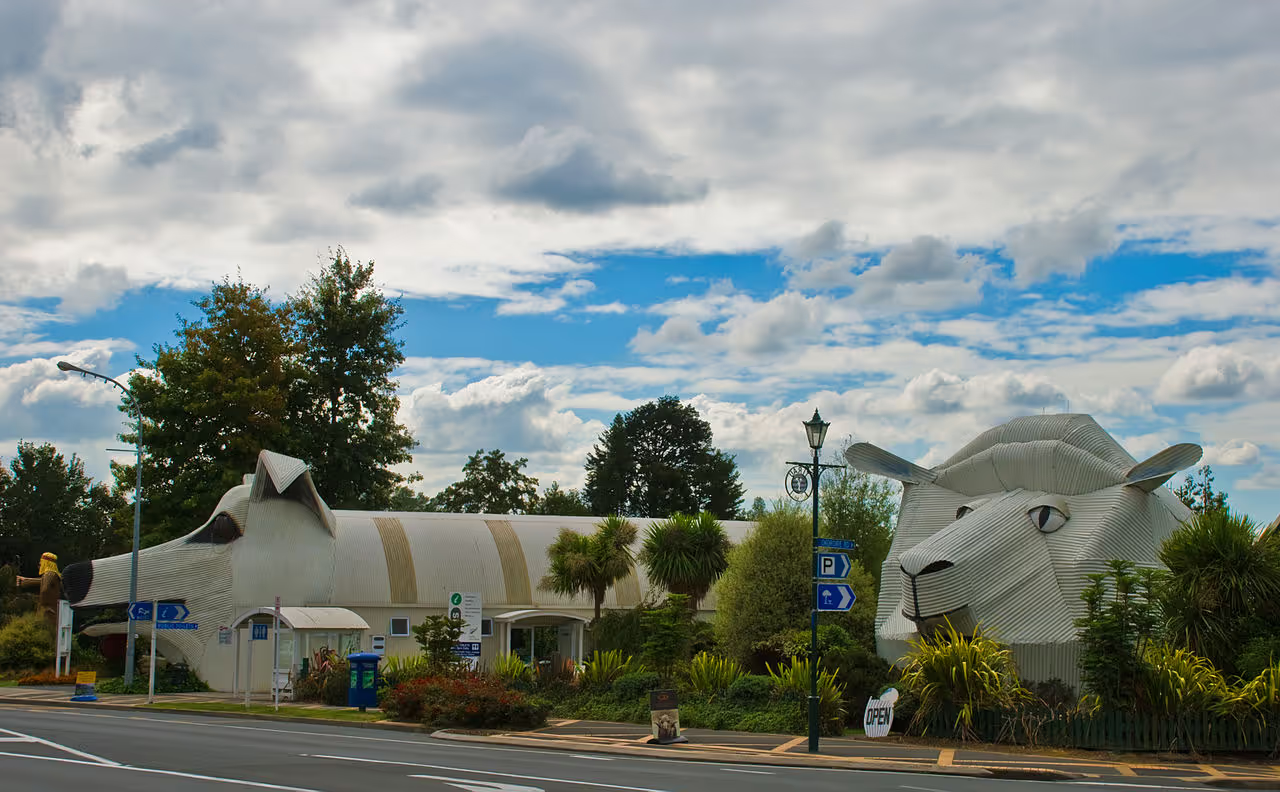
In the small town of Tirau, two oversized corrugated iron crazy buildings shaped like a sheep and a dog welcome visitors. Their forms are playful but practical. These unique architecture buildings are designed to attract tourists driving through rural New Zealand.
The sheep opened first as the townŌĆÖs (tourist info center), followed by the dog, which houses a wool and craft shop. A third structure, shaped like a ram, was added in 2016. The Sheep and Dog buildings are open to the public and have become a quirky local landmark.
- Location: Tirau, New Zealand
- Construction timeline: 1990 - 1998 (ram added in 2016)
- Architect / Firm: Steven Clothier (local business owner/designer)
- Style or movement: Novelty architecture
- Materials or unique features: Corrugated iron, timber framing
- Engineering method: Custom-framed structures with shaped iron sheeting
- Original use: Tourist information and retail
- Current use: Same as original
- Public access: Yes
- Construction cost: Not publicly disclosed
The sheep and dog buildings helped transform Tirau into a roadside attraction. These unique buildings are also a nod to New ZealandŌĆÖs farming culture, where sheep famously outnumber people. Their success shows how unconventional design can bring economic life to a small town.
4. Gate Tower Building: The Office with a Highway Inside
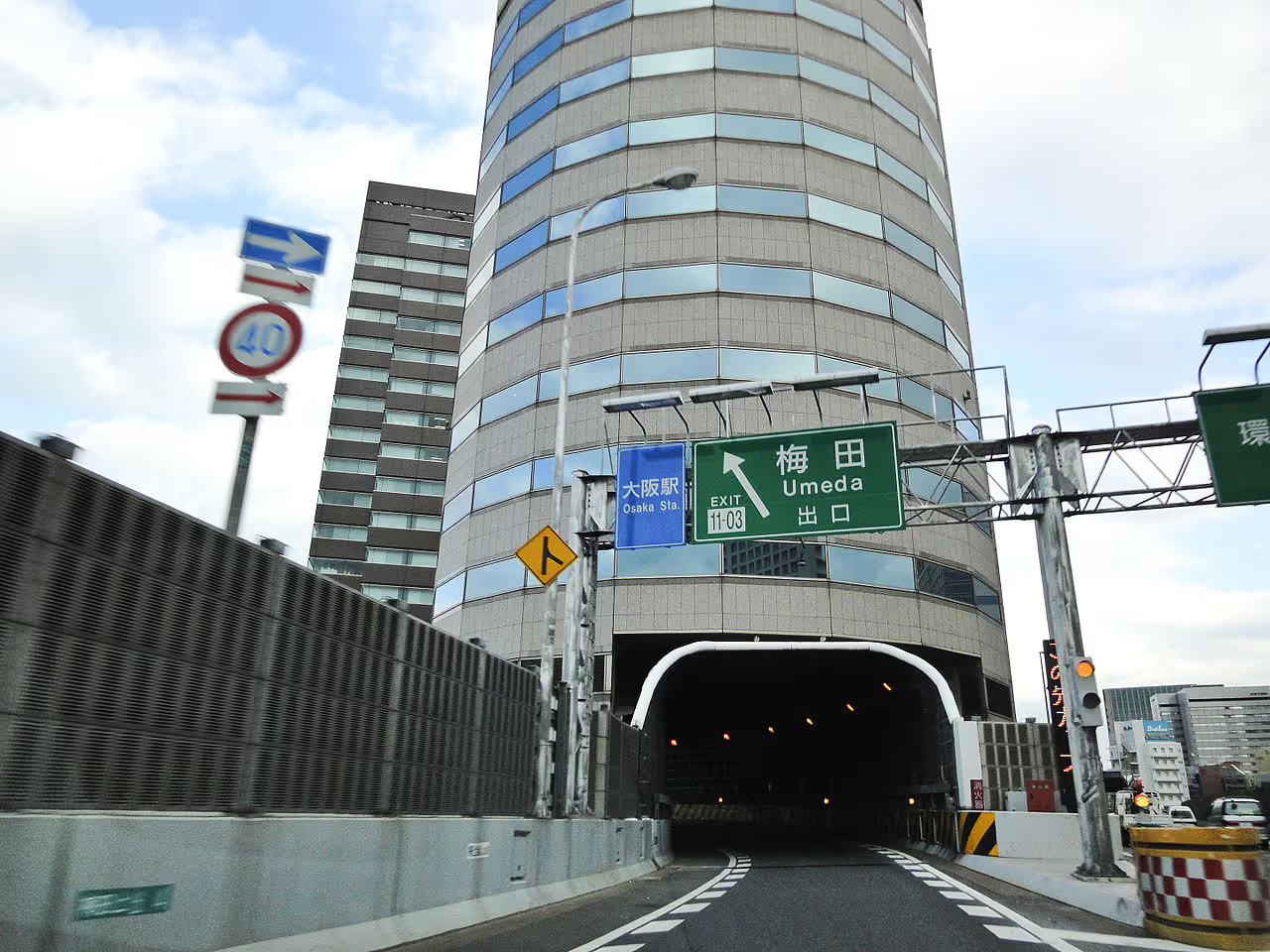
The Gate Tower Building is a 16-story office tower in Osaka that has an expressway cutting straight through its 5th to 7th floors. The highway doesn't touch the building. But, it's supported by its own structure and passes through like a tunnel in mid-air. The weirdest buildings list would be incomplete without it.
The buildingŌĆÖs design came from a land rights dispute that led to a creative compromise. Despite its odd look, the functions like any normal office block. Tenants use elevators and stairs that skip the highway levels entirely.
- Location: Osaka, Japan
- Construction timeline: 1989 - 1992
- Architect / Firm: Azusa Sekkei and Yamamoto-Nishihara Kenchiku Sekkei
- Style or movement: High-tech / pragmatic hybrid
- Materials or unique features: Reinforced concrete, highway pier integration
- Engineering method: Highway structure isolated with vibration dampers; no load transfer to the building
- Original use: Office tower
- Current use: Office tower
- Public access: No (offices only)
- Construction cost: Not publicly disclosed
The highway company pays rent to occupy the middle floors. Rent is about ┬ź2.5 million (roughly $15,000 USD) per month. The Gate Tower project showcases how urban planning, law, and engineering can come together in unexpected ways to solve dense city challenges.
5. Lotus Temple: A Flower-Shaped House of Worship

The Lotus Temple in New Delhi is shaped like a blooming white lotus, with 27 marble-clad petals arranged in clusters. Its smooth, organic form draws visitors from all backgrounds and faiths. There are no idols, sermons, or rituals. ItŌĆÖs just an open space.
The Lotus Temple serves as a , one of only a few like it in the world. ┬ĀIt's one of IndiaŌĆÖs most visited buildings. This interesting architecture draws millions each year, all curious to see one of the most unique buildings in the world.
- Location: New Delhi, India
- Construction timeline: 1980 - 1986
- Architect / Firm: Fariborz Sahba
- Style or movement: Expressionist architecture
- Materials or unique features: White marble from Greece, petal-inspired concrete shells
- Engineering method: Structural ribs within petals; poured-in-place concrete with marble cladding
- Original use: Bah├ĪŌĆÖ├Ł House of Worship
- Current use: Same as original
- Public access: Yes
- Construction cost: Estimated $10 million
The lotus was chosen for its universal symbolism in Indian culture of spirituality, purity, and peace. The Lotus Temple has won multiple architecture awards and was featured in Architectural DigestŌĆÖs . ItŌĆÖs as much a symbol of unity as it is a feat of design.
6. Guggenheim Museum: Spiral-Shaped Art Icon

The flips the idea of a museum on its head, literally. Instead of separate gallery rooms, visitors walk up a continuous spiral ramp. Its design has secured its place among the most interesting buildings ever built.
The Guggenheim museum was commissioned by art collector Solomon R. Guggenheim. It was designed to house modern art in a modern way. The layout drew mixed reactions at first but is now celebrated as a landmark in both art and architecture.
- Location: New York City, USA
- Construction timeline: 1956 - 1959
- Architect / Firm: Frank Lloyd Wright
- Style or movement: Organic architecture / Modernism
- Materials or unique features: Reinforced concrete, spiral ramp, domed glass skylight
- Engineering method: Load-bearing walls with cantilevered ramp structure
- Original use: Art museum
- Current use: Same as original
- Public access: Yes
- Construction cost: Estimated $3 million (equivalent to over $30 million today)
famously said the Guggenheim building would make the nearby Metropolitan Museum ŌĆ£look like a Protestant barn.ŌĆØ Today, the Guggenheim is a UNESCO World Heritage Site and one of the most visited museums in the world.
7. Kunsthaus Graz: AustriaŌĆÖs Friendly Alien
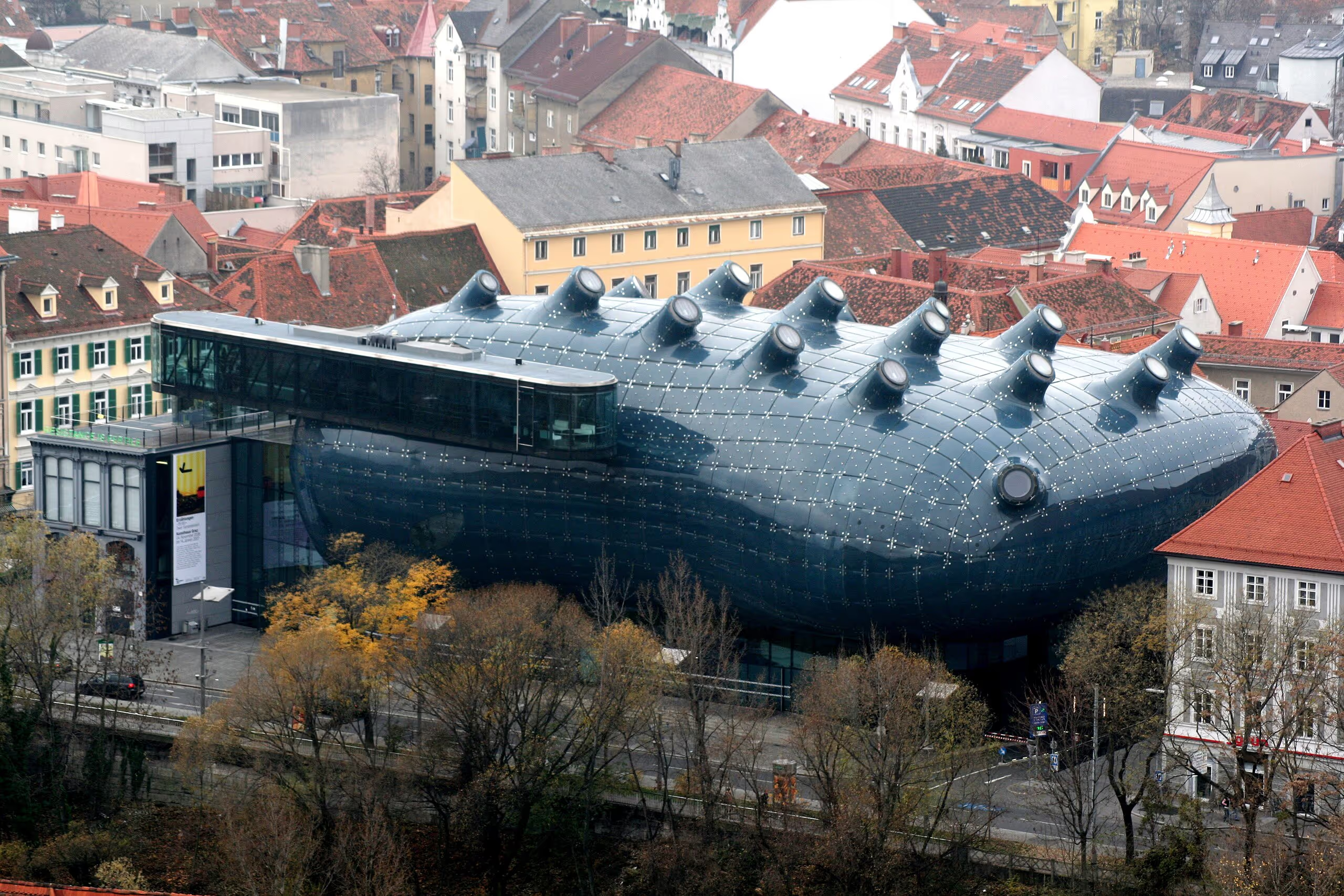
Nicknamed the ŌĆ£Friendly Alien,ŌĆØ looks more like a sci-fi creature than an art museum. This blob of weird architecture is hard to miss and often ranks in lists of unique buildings in the world.
Built for the European Capital of Culture program in 2003, the Kunsthaus Graz museum focuses on contemporary art. It has no permanent collection and is used for rotating exhibitions, workshops, and events. This unique building itself has become a work of art and a symbol of the cityŌĆÖs bold design spirit.
- Location: Graz, Austria
- Construction timeline: 2001 - 2003
- Architect / Firm: Peter Cook and Colin Fournier
- Style or movement: Blob architecture / Futurist
- Materials or unique features: Blue acrylic panels, steel skeleton, ŌĆ£nozzleŌĆØ skylights
- Engineering method: Free-form steel frame with computer-modeled geometry
- Original use: Contemporary art museum
- Current use: Same as original
- Public access: Yes
- Construction cost: Approx. Ōé¼38 million
The Kunsthaus GrazŌĆÖ shape was digitally modeled and prefabricated, then assembled on-site. This technique is an early example of using parametric design in construction. Its playful form sparked local debate but ultimately helped reposition Graz as a forward-looking cultural hub.
8. La Pedrera (Casa Mil├Ā): A Building with No Straight Lines

Casa Mil├Ā, known as or ŌĆ£The Stone Quarry,ŌĆØ is one of Antoni Gaud├ŁŌĆÖs most famous residential buildings. Its undulating stone fa├¦ade and twisting wrought-iron balconies make it instantly recognizable. The rooftop features chimneys shaped like surreal sculptures.
Built as an apartment complex, La Pedrera now houses a cultural center, museum, and exhibition spaces. Visitors can explore the rooftop, inner courtyards, and a recreated early 20th-century flat. It remains a key stop on BarcelonaŌĆÖs modernist architecture trail.
- Location: Barcelona, Spain
- Construction timeline: 1906 - 1912
- Architect / Firm: Antoni Gaud├Ł
- Style or movement: Catalan Modernisme (Art Nouveau)
- Materials or unique features: Limestone fa├¦ade, self-supporting stone walls, iron balconies
- Engineering method: Steel-beam internal structure, open floor plans without load-bearing walls
- Original use: Private residence with rental apartments
- Current use: Cultural venue and museum
- Public access: Yes
- Construction cost: Not publicly recorded (funded by the Mil├Ā family)
La Pedrera was declared a . However, Gaud├ŁŌĆÖs unconventional approach was controversial at the time. Today, La PedreraŌĆÖs seen as a masterpiece of structural creativity and organic architecture.
9. Teapot Building: ChinaŌĆÖs Spinning Kettle
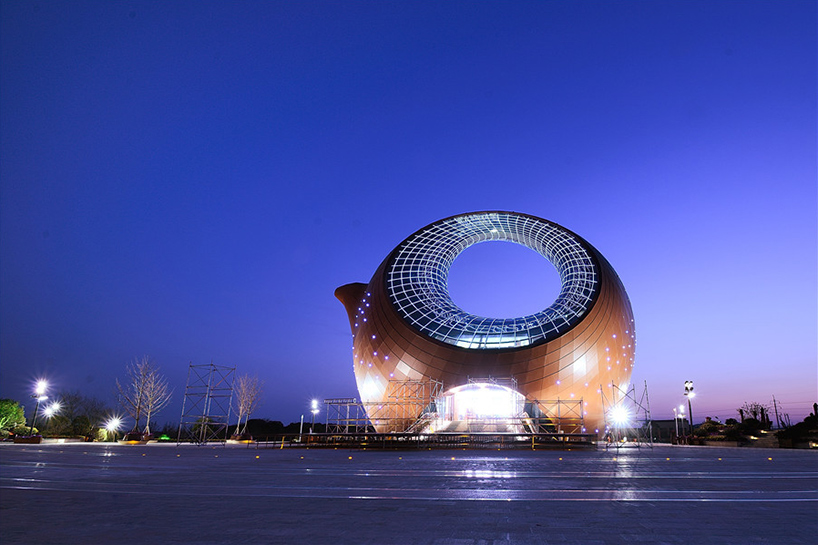
The Teapot Building in Wuxi, China, is shaped exactly like a giant brown teapot with handle, spout, and lid included. It once served as a local tourist information center and featured a rotating structure at its base. Its playful design attracted attention but also sparked official criticism.
The Teapot building is no longer in use, and similar novelty designs have since been discouraged by Chinese authorities. In 2016, in public projects. The Teapot House remains a quirky symbol of a brief era of architectural experimentation.
- Location: Wuxi, Jiangsu Province, China
- Construction timeline: Early 2000s (exact date unclear)
- Architect / Firm: Not publicly credited
- Style or movement: Novelty architecture
- Materials or unique features: Circular base, rotating platform, shaped fa├¦ade
- Engineering method: Internal steel framing; motorized rotating base
- Original use: Tourist information center
- Current use: Vacant / closed to the public
- Public access: No
- Construction cost: Not publicly disclosed
While eye-catching, the Teapot House building became a national example of what planners called ŌĆ£weird architecture.ŌĆØ It played a part in shaping China's new focus on ŌĆ£suitable, green, and economicalŌĆØ public buildings. Today, itŌĆÖs mostly viewed as a cultural curiosity from a more experimental time.
10. Crooked House: PolandŌĆÖs Warped Fairytale
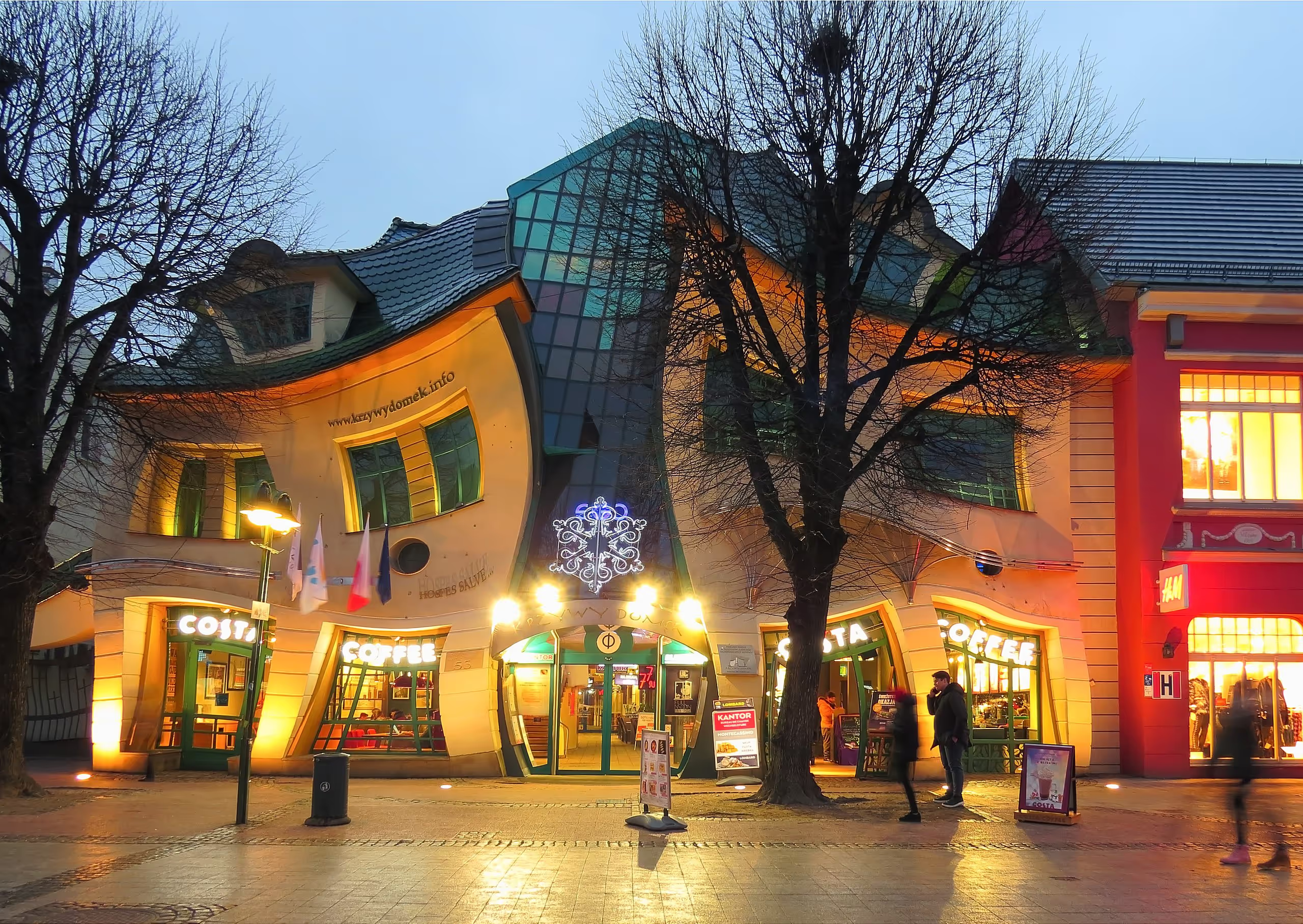
The Crooked House (Krzywy Domek) in Sopot, Poland, looks like it melted under a heat lamp. Inspired by fairytale illustrations, its walls bend and windows bulge, giving it a surreal, cartoonish appearance. It was built to house shops, restaurants, and offices in a local shopping center.
Despite its playful look, the functions like any standard commercial building. Visitors can walk inside, dine, and shop while surrounded by its wobbly walls. ItŌĆÖs one of the most photographed buildings in Poland.
- Location: Sopot, Poland
- Construction timeline: 2003 - 2004
- Architect / Firm: Szotyńscy & Zaleski
- Style or movement: Postmodern / Storybook style
- Materials or unique features: Glass, steel, concrete with curved fa├¦ades
- Engineering method: Complex fa├¦ade modeling with reinforced concrete shell
- Original use: Commercial retail and office space
- Current use: Same as original
- Public access: Yes
- Construction cost: Not publicly disclosed
The Crooked House unique design was inspired by the fairytale drawings of Jan Marcin Szancer and Per Dahlberg. ItŌĆÖs part of the Rezydent shopping center and remains a major tourist draw. Locals call it ŌĆ£the drunk house,ŌĆØ a nickname Krzywy Domek fully earns with its distorted shape.
11. Museu de Arte Contemporânea: A UFO Above the Bay

Hovering above Guanabara Bay, the in Niter├│i looks like a flying saucer about to take off. Its circular structure is set on a cliff, supported by a narrow base and reached via a long red ramp. The shape also creates dramatic reflections in the water below.
Designed to hold modern art exhibitions, the Museu de Arte Contempor├ónea remains active and open to the public. Its striking form and seaside location make it one of BrazilŌĆÖs most iconic architectural sites. Visitors come for both the art and the panoramic views.
- Location: Niter├│i, Rio de Janeiro, Brazil
- Construction timeline: 1991 - 1996
- Architect / Firm: Oscar Niemeyer
- Style or movement: Modernist / Futurist
- Materials or unique features: Reinforced concrete, circular design, cantilevered disk
- Engineering method: Central structural core with radial supports
- Original use: Contemporary art museum
- Current use: Same as original
- Public access: Yes
- Construction cost: Estimated $10 million
Niemeyer called the Museu de Arte Contempor├ónea a ŌĆ£flower growing from the rock,ŌĆØ though most see a spaceship. This strange-looking building has been praised for merging bold form with elegant engineering. ItŌĆÖs frequently listed among the most recognizable museums in the world.
12. Staircase to Heaven: Concrete Dreams in the Jungle
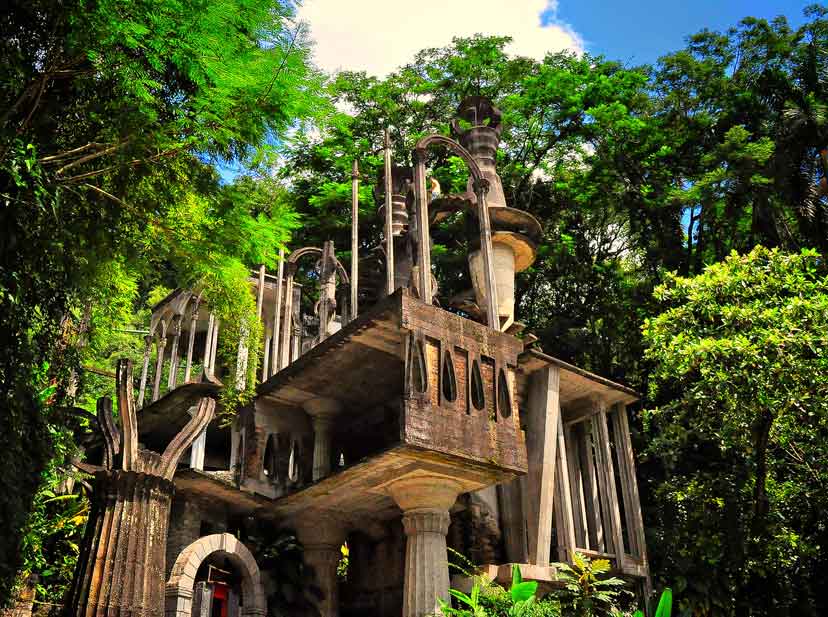
Hidden in the Mexican jungle, the ŌĆ£Staircase to HeavenŌĆØ is part of , a surrealist garden built by Edward James, a British poet and art patron. This crazy building features columns, arches, and stairs that lead nowhere, blending architecture with fantasy. It was never fully completed, adding to its dreamlike feel.
Originally conceived as a personal retreat, the site now operates as a public sculpture park. Visitors can explore the lush grounds and concrete structures year-round. Staircase to Heaven is one of MexicoŌĆÖs most unusual and imaginative architectural sites.
- Location: Xilitla, San Luis Potos├Ł, Mexico
- Construction timeline: 1949 - 1984
- Architect / Firm: Edward James (conceptual designer); Plutarco Gast├®lum Esquerra (builder)
- Style or movement: Surrealist architecture / Organic fantasy
- Materials or unique features: Concrete, jungle setting, staircases without destination
- Engineering method: Handmade concrete forms integrated into natural terrain
- Original use: Private garden and retreat
- Current use: Public sculpture park
- Public access: Yes
- Construction cost: Privately funded (exact figures unknown)
James spent much of his fortune on Las Pozas. The Staircase to Heaven reflects his belief in creating spaces where logic gives way to imagination. It remains a rare example of surrealism built at an architectural scale.
13. Kansas City Public Library: The Parking Garage of Giant Books
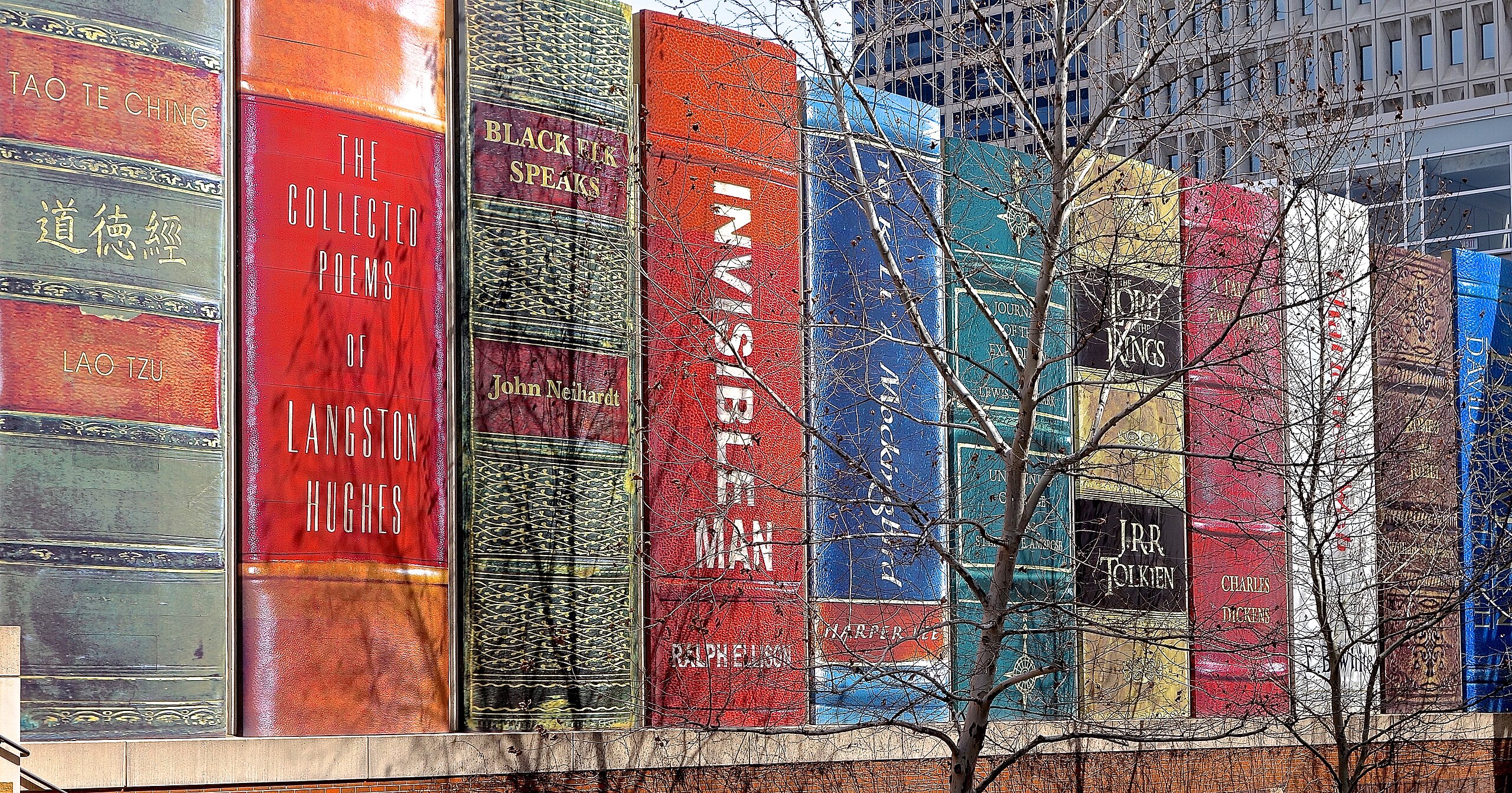
The downtown parking garage features a massive fa├¦ade designed to look like a row of giant books. Each spine is about 25 feet tall and represents a title chosen by local residents. ItŌĆÖs one of the most creative uses of a parking structure in the U.S.
Behind the oversized ŌĆ£booksŌĆØ of the Kansas City Public Library garage serves everyday visitors to the library and nearby buildings. The main library itself is housed in a historic former bank next door. Together, these unique buildings blend classic architecture with playful design.
- Location: Kansas City, Missouri, USA
- Construction timeline: 2004
- Architect / Firm: Dimensional Innovations (fa├¦ade design); BNIM (library renovation)
- Style or movement: Novelty architecture / Adaptive reuse
- Materials or unique features: Concrete garage with printed graphic panels
- Engineering method: Aluminum and signboard materials mounted to concrete frame
- Original use: Parking garage for library patrons
- Current use: Same as original
- Public access: Yes
- Construction cost: Approx. $50 million (entire library renovation project)
The titles include classics like The Lord of the Rings, To Kill a Mockingbird, and Invisible Man. The Kansas City Public Library a community-driven design that celebrates reading while transforming an ordinary structure into something iconic.
14. Dongdaemun Design Plaza: Spaceship in the Heart of Seoul
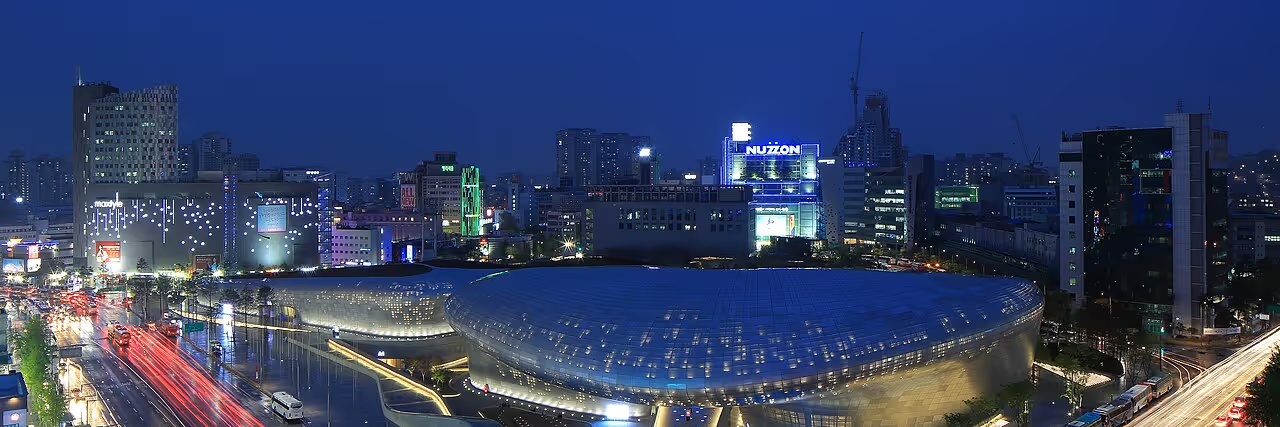
The (DDP) looks like a giant metallic blob landed in the middle of a shopping district. Its smooth, flowing curves are wrapped in aluminum panels and lit by LEDs that shift color at night. The weird building feels futuristic but remains practical.
Opened as a multi-use cultural complex, the Dongdaemun Design Plaza houses museums, exhibition halls, shops, and rooftop parks. It quickly became one of SeoulŌĆÖs most visited public spaces. Tourists and locals alike use it for events, photos, and casual walks.
- Location: Seoul, South Korea
- Construction timeline: 2009 - 2014
- Architect / Firm: Zaha Hadid Architects
- Style or movement: Parametric design / Neo-futurism
- Materials or unique features: Curved aluminum panels, LED lighting, organic forms
- Engineering method: Digital modeling with 3D BIM and CNC fabrication for custom parts
- Original use: Design and culture hub
- Current use: Same as original
- Public access: Yes
- Construction cost: Approx. $450 million USD
DDP was one of . Its shape defied conventional construction methods and required digital fabrication on a massive scale. Today, itŌĆÖs a landmark for both architecture lovers and SeoulŌĆÖs fashion-forward youth.
15. Sheraton ŌĆ£HorseshoeŌĆØ Hotel: Glowing Donut on the Water
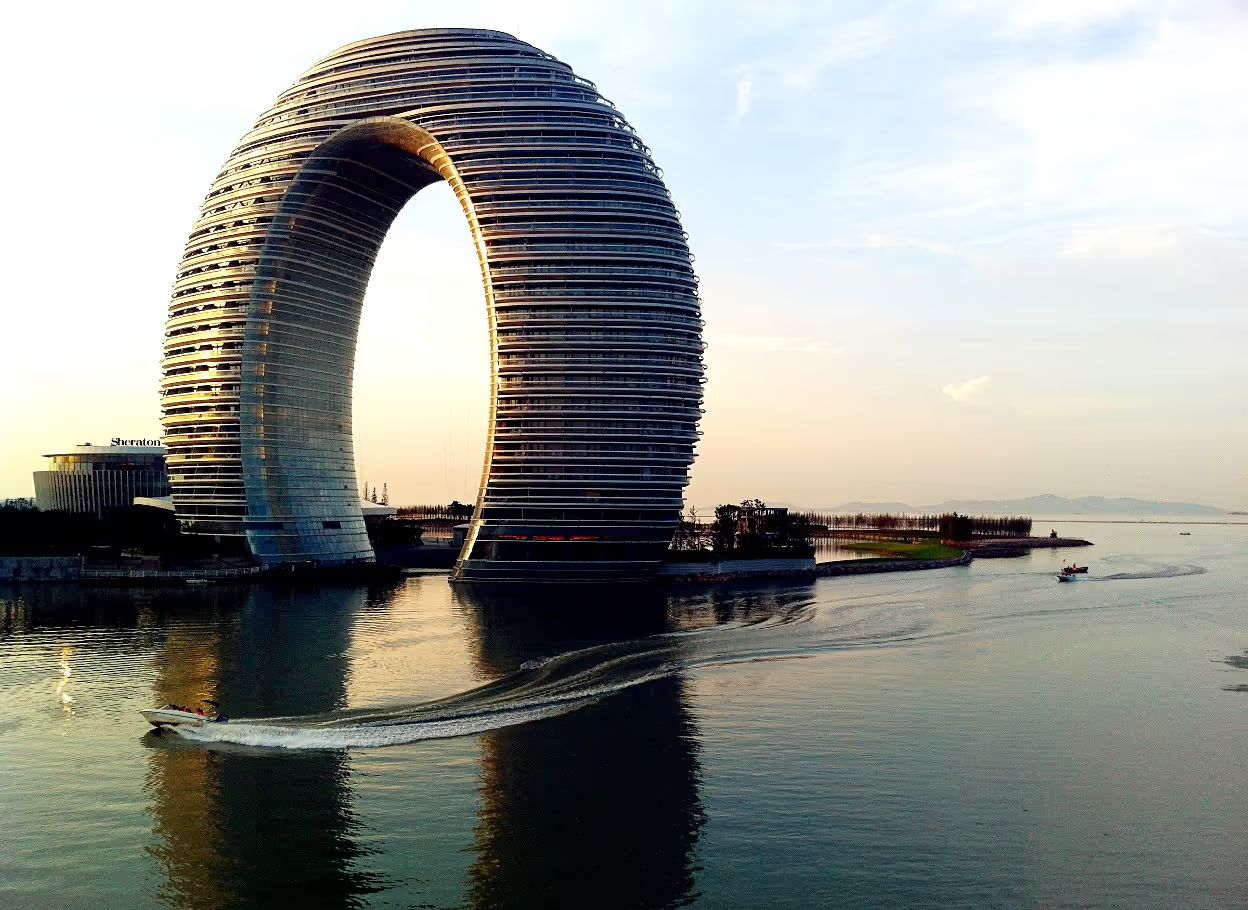
Shaped like a giant horseshoe or a full moon rising from the lake, the curves 360 degrees to form a complete ring. Its mirrored glass fa├¦ade reflects the water below by day and lights up in color at night. The unique shape also creates panoramic views from every room.
Located on Lake Taihu, the Sheraton ŌĆ£HorseshoeŌĆØ hotel includes 321 guest rooms, restaurants, and a spa. It was built as a luxury destination and remains fully operational. Visitors can book rooms and dine while surrounded by its bold architecture.
- Location: Huzhou, Zhejiang Province, China
- Construction timeline: 2008 - 2013
- Architect / Firm: MAD Architects (design); Shanghai Feizhou Group (developer)
- Style or movement: Neo-futurism
- Materials or unique features: Glass curtain wall, steel structure, elliptical shape over water
- Engineering method: Twin tower cores joined at top and base; steel bridge integration over water
- Original use: Hotel and resort
- Current use: Same as original
- Public access: Yes (hotel guests and visitors)
- Construction cost: Estimated $1.5 billion RMB (approx. $240 million USD)
Nicknamed the ŌĆ£Horseshoe HotelŌĆØ by locals, the Sheraton Hotel was praised for blending bold form with waterfront design. It has won multiple design awards and appeared in international architecture magazines. The ring shape also reduces solar heat gain on the guestroom fa├¦ades.
16. TWA Hotel (JFK Terminal 5): A Jet Age Terminal Reborn

Once the terminal for Trans World Airlines, this swooping white structure now serves as a hotel within JFK Airport. Its curved concrete shell and soaring interior pay tribute to the optimism of 1960s aviation. The weird design features split-level lounges and massive glass walls overlooking runways.
After sitting unused for years, was restored and expanded into a 512-room hotel. It includes a rooftop pool, event spaces, and exhibits on airline history. Guests can stay overnight or visit for food, drinks, and views.
- Location: New York City, USA
- Construction timeline: 1956 - 1962 (original terminal); reopened as hotel in 2019
- Architect / Firm: Eero Saarinen (original); Beyer Blinder Belle and Lubrano Ciavarra (renovation)
- Style or movement: Mid-century modern / Neo-futurist
- Materials or unique features: Reinforced concrete shell, custom glass curtain walls
- Engineering method: Original shell restored; modern additions built underground and around it
- Original use: Airline terminal for TWA
- Current use: Hotel and event venue
- Public access: Yes
- Construction cost: Estimated $265 million (renovation and hotel conversion)
The TWA Flight Center is listed on the . Its revival preserved one of the most iconic airport terminals in history. The renovation balances nostalgia with new use, making it a model for adaptive reuse in aviation architecture.
17. The Forest Tower: A Spiraling Walkway Above the Treetops
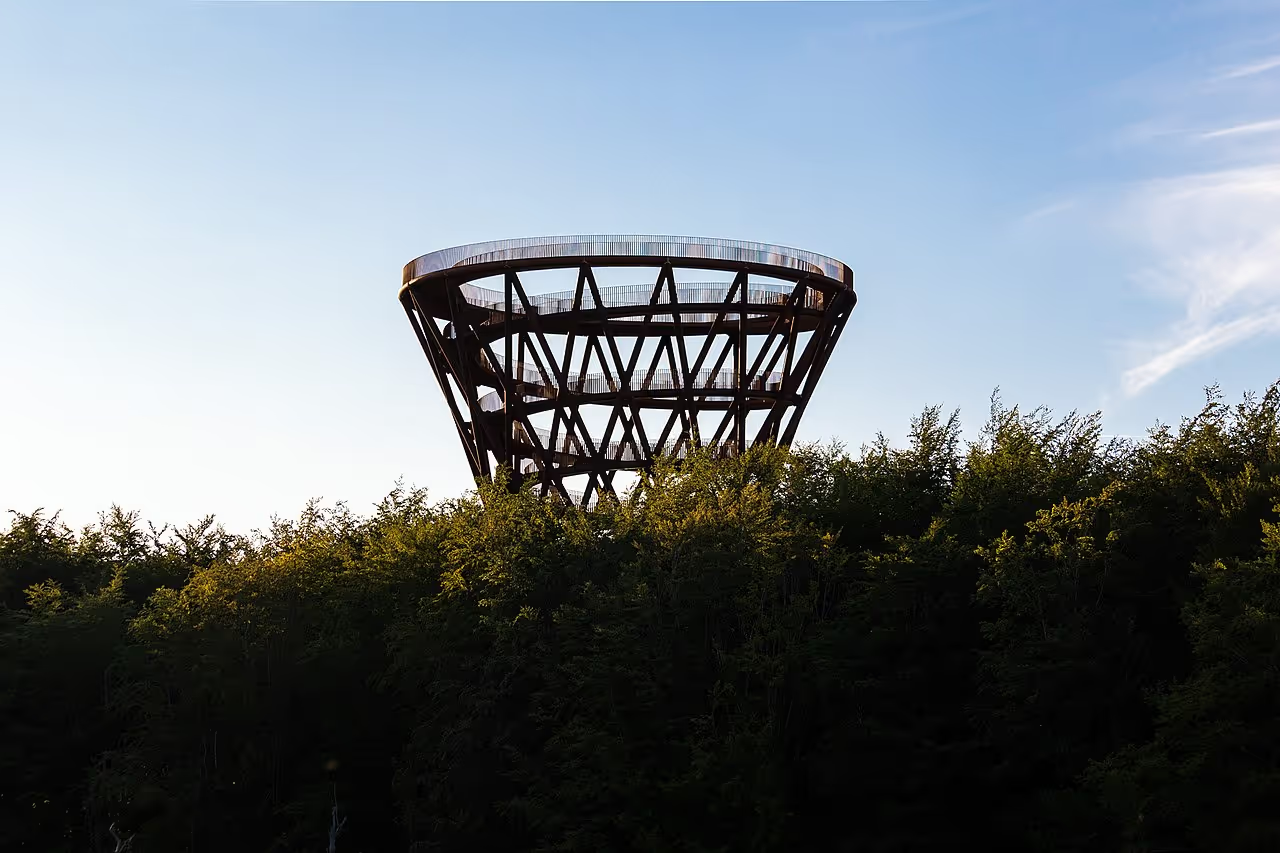
The Forest Tower rises 45 meters above the trees in a Danish forest, shaped like a twisted hourglass. Visitors walk up a spiraling ramp that offers sweeping views of the canopy and surrounding countryside. The tower blends naturally into the forest while offering an elevated experience.
The , an outdoor recreation site about an hour from Copenhagen. The weird architecture is open year-round and welcomes hikers, families, and tourists. ItŌĆÖs designed to be fully accessible, with a gentle slope and wide pathway.
- Location: Gisselfeld Klosters Skove, Zealand, Denmark
- Construction timeline: 2018 - 2019
- Architect / Firm: EFFEKT Architects
- Style or movement: Sustainable architecture / Landscape-integrated design
- Materials or unique features: Corten steel, oak wood, 650-meter spiraling ramp
- Engineering method: Structural steel core with radial bracing; designed for minimal forest impact
- Original use: Observation and walking tower
- Current use: Same as original
- Public access: Yes (ticketed entry)
- Construction cost: Approx. Ōé¼2.3 million
The Forest Tower won the . It offers a rare combination of environmental sensitivity and eye-catching form. The structure brings people closer to nature, without disturbing it.
18. Aldar HQ: The Desert Circle
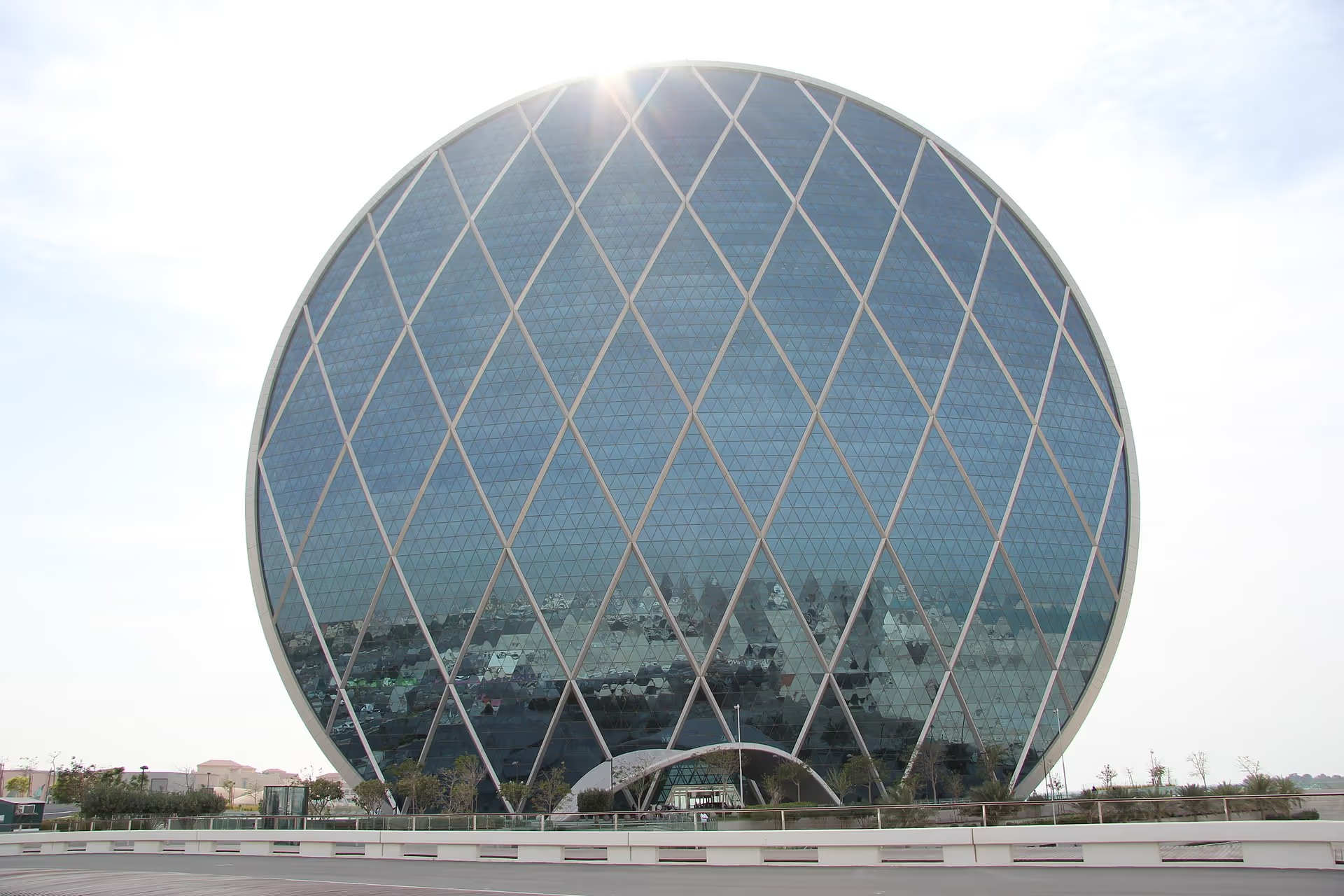
The in Abu Dhabi is the worldŌĆÖs first circular skyscraper. Its disc-like shape was achieved using a diagonal grid of steel and glass, creating a striking silhouette against the skyline. The symmetry is precise, with identical curved fa├¦ades front and back.
Built for a real estate development firm, Aldar's unique architecture contains office space across 23 floors. The Aldar HQ is fully functional and remains in active use by Aldar Properties. The structure is visible from major highways and has become a regional icon.
- Location: Al Raha Beach, Abu Dhabi, UAE
- Construction timeline: 2007 - 2010
- Architect / Firm: MZ Architects
- Style or movement: High-tech / Neo-futurist
- Materials or unique features: Diagrid steel structure, reflective glass panels
- Engineering method: Diagonal grid (diagrid) system to eliminate internal columns
- Original use: Corporate headquarters
- Current use: Same as original
- Public access: No (corporate offices)
- Construction cost: Approx. AED 1 billion (approx. $270 million USD)
The Aldar HQ building won the (BEX) Conference. Its circular form symbolizes unity and stability in Arabic culture. It also demonstrates how geometry can drive both design and engineering performance.
19. The National Museum of African American History (NMAAH): The Bronze Crown

The tells a story before you even step inside. The Yoruban caryatid, a traditional West African column form, inspired the museumŌĆÖs tiered design. Its bronze-colored metal lattice reflects historical ironwork crafted by enslaved African Americans.
Opened in 2016, NMAAH houses exhibitions on history, culture, and contributions of African Americans. Visitors enter through a darkened gallery below ground and rise through the story chronologically. ItŌĆÖs part of the Smithsonian Institution and open daily to the public.
- Location: Washington, D.C., USA
- Construction timeline: 2012 - 2016
- Architect / Firm: Freelon Adjaye Bond/SmithGroup; lead designer: David Adjaye
- Style or movement: Contemporary African-American architecture
- Materials or unique features: Bronze-colored aluminum panels, glass curtain wall, corona-inspired form
- Engineering method: Tiered steel frame with deep foundation; solar shading via patterned panels
- Original use: National museum
- Current use: Same as original
- Public access: Yes (free, timed-entry required)
- Construction cost: Approx. $540 million USD
The National Museum of African American History has received global acclaim for both its exhibits and its unique architecture. It was named and has won multiple design awards. Its crown-like form is a powerful visual statement on legacy and presence.
20. Haines Shoe House: The Five-Storey Shoe

A five-story boot you can tour? ThatŌĆÖs about as crazy building as it gets. The continues to charm tourists with its unique appearance and its place in American roadside culture.
Originally used to house contest winners and promote Haines' shoe stores, the building later became a private residence. Today, itŌĆÖs open seasonally for public tours and includes an ice cream shop. It remains a roadside attraction along Route 30 in Pennsylvania.
- Location: Hellam Township, Pennsylvania, USA
- Construction timeline: 1948 - 1949
- Architect / Firm: Designed by Mahlon Haines; built by local contractors
- Style or movement: Novelty architecture
- Materials or unique features: Concrete and wire mesh over a wooden frame
- Engineering method: Custom frame built to shoe-shaped forms; functional interior layout
- Original use: Promotional guesthouse for Haines Shoe Company
- Current use: Museum and seasonal tourist attraction
- Public access: Yes (seasonal, guided tours)
- Construction cost: Estimated $20,000 (in 1949 USD)
The Haines Shoe house gained media attention soon after opening and was featured in national news. Its whimsical design helped Haines grow his brand across the region. Today, itŌĆÖs a nostalgic symbol of mid-century roadside Americana.
What Makes These Weird Buildings Work?
Even the wildest buildings in the world still have to meet real-world demands. They need to stand up, stay functional, and pass inspections, just like every other project. HereŌĆÖs how bold architecture becomes buildable.
Form Meets Function
A unique shape doesnŌĆÖt mean you have to sacrifice usability. In fact, some of these interesting buildings are surprisingly practical. The Basket Building worked as a corporate office. The Dancing House is a working office tower. The Gate Tower in Osaka literally has a highway passing through it, and it still houses tenants.
The key is thoughtful planning. Architects and engineers collaborate early to make sure curves, angles, or cantilevers donŌĆÖt get in the way of real use. Structural systems, HVAC routing, and circulation paths are all adapted to fit the form, not the other way around.
Relying on Smarter Planning Tools
When a building twists or bends, standard tools often arenŌĆÖt enough. These crazy projects usually rely on 3D modeling and BIM to resolve issues before construction starts. Non-linear geometry means unique components: custom glazing, steel frames, concrete formwork, and even MEP systems.
That complexity also means more coordination across trades. Every curved panel, angled beam, or oddly shaped wall becomes a point of detail. Without clear coordination from the start, these builds can spiral in cost and timeline fast.
Using the Right Materials
You canŌĆÖt build a spiral tower with off-the-shelf materials. Projects like the Forest Tower in Denmark or Dongdaemun Design Plaza in Seoul used corten steel, custom-fabricated panels, and double-curved surfaces that needed special handling.
Whether itŌĆÖs free-form concrete, glass-fiber panels, or prefabricated structural frames, these materials expand design freedom. But, they also demand precise detailing and expert installers.
Success often comes down to matching the design ambition with the right supply chain and fabrication partners.
Final Thoughts on Unique Buildings: Built Weird. Built Well.
You donŌĆÖt have to build a hotel shaped like a shoe or run a highway through an office tower. However, these buildings demonstrate that when a bold idea meets solid execution, something truly memorable can occur.
Unique projects come with more questions, more approvals, and more unknowns. But they also open the door to creativity, smarter materials, and new ways of thinking about space. For builders and architectural firms, theyŌĆÖre a reminder that the job isnŌĆÖt just to get it done; itŌĆÖs to make something worth doing.



